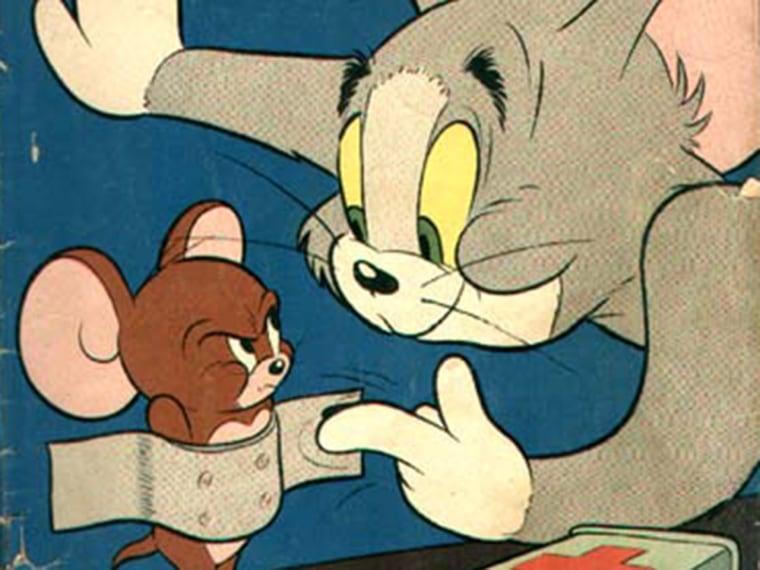Take a cat, take a mouse, and let them chase each other. That’s pretty much the story line of all 163 “Tom & Jerry” cartoons that started airing in 1940. It's good, wholesome kids fare.
But what if you took that same cat, and that same mouse, and put them into blackface?
That's what happened in 1948’s “Mouse Cleaning,” when Tom briefly wears blackface, and in 1951’s “Casanova Cat,” where Jerry ends up doing a minstrel act while in blackface.
It's hard to imagine either cartoon showing up on TV today, and there's lots of other cartoon content from the early to mid-20th Century that is no longer considered acceptable fare for mass audiences, especially children. Sure, cartoons like "Mouse Cleaning" live on the internet, as do other shorts with challenging content. But what should happen to them?
That's the battle: Studios can get nervous about revisiting their history by releasing DVD collections that includes the offending material ("Tom & Jerry: The Golden Collection Vol. 2," which would have featured "Mouse Cleaning" and "Casanova Cat," is being "postponed," said a Warner Bros. Home Video rep). But animation historians say that's the wrong attitude to take, noting that when the cartoons are put in the right context, they can be treated as the art form they actually are.
“You can’t censor these things and put them away and pretend they never happened,” said Raul Aguirre, a former Disney animator who now runs the podcast “Man Vs. Art.” “Those cartoons represent a stage our culture was in at the time. As a cartoonist, our work reflects what’s going on in the world.”
The history of cartoons is also the history of their censorship. Over the decades, cartoon collections like "Merrie Melodies" or "Looney Tunes" have been edited or hidden away before airing for reasons including excessive violence and racist characterizations. But it's worth bearing in mind that those old cartoons were originally designed for all ages to see in the movie theater, then altered once brought to TV and targeted solely at children.
“The networks or the studio don’t want to expose that to kids,” said animation historian Jerry Beck, who runs the website Cartoon Research. “The problem is that people who grew up and loved those cartoons, they’re works of art and are part of film history. It’s disturbing that they get censored and edited.”
Older cartoons aren’t the only sort that have experienced jittery network or studio censorship. As Mathew Klickstein, author of “Slimed: An Oral History of Nickelodeon’s Golden Age,” says, early Nick cartoons like “Ren and Stimpy” and even “Rugrats” contained content that made studios nervous.
In “Naked Tommy,” a 1994 episode of "Rugrats," all of the children shuck off their clothing; before the episode was animated one director was hoping to do a “full frontal” of the children, inspired by Maurice Sendak’s “In the Night Kitchen.”
“Basically, Nickelodeon sent back the storyboards and said, ‘Have you gone mad?’” Klickstein said.
More problematic for the network was “Ren and Stimpy,” which felt like a subversive version of a kids’ cartoon, and featured an “almost S&M relationship between Ren and Stimpy," says Klickstein.
“The violence, the puking, the farting, and the scatological stuff – that’s what they wanted, that’s what they were buying when they hired (creator John Kricfalusi),” Klickstein said. “But the anger of some of those characters made them nervous.”
It all came to a head with 1992’s “Man’s Best Friend,” which got banned from Nickelodeon for violence, tobacco usage and too many scatological jokes even for the network. (It saw air on Spike in 2003.) But that episode led to Kricfalusi being canned.
Still, it’s the omission of entire episodes from DVD collections that rankle animation experts most. Aguirre says that as a Mexican-American, for example, he’s disappointed at the way “Speedy Gonzalez” cartoons have all but vanished from the airwaves. (Debate rages in the Latino-American community over whether those cartoons are racially-insensitive; Gonzalez is a hero, but the other mice around him are often portrayed as slow or lazy.)
“They’re totally overcompensating now,” says Aguirre. “You alienate and upset people because you’re trying to cover up culture, and that’s what irks people.”
There are other ways of dealing with changing social definitions of political correctness, however, than just pulling whole collections from the shelves. Historians like Beck point to the way Disney has handled it, with its “Walt Disney Treasures” DVDs, packaged in sober silver boxes rather than garish kid-friendly colors, and hosted by critic Leonard Maltin.
“They've released every cartoon with racial stereotypes, Mickey Mouse as Uncle Tom, all stuff that would not run on the Disney Channel,” says Beck (who acknowledges that Disney is imperfect, keeping its partially-animated “Song of the South” film under wraps). “They put those things out without complaint by anybody, because they’re in context.”
Maltin agrees. “I understand a studio’s reluctance to show racially and ethnically-sensitive images to children,” he writes in an email. “That’s an appropriate stance to take. But … if you put these cartoons into a proper historical context — and warn parents that they may find those episodes offensive or inappropriate — I think you've done your due diligence.”
